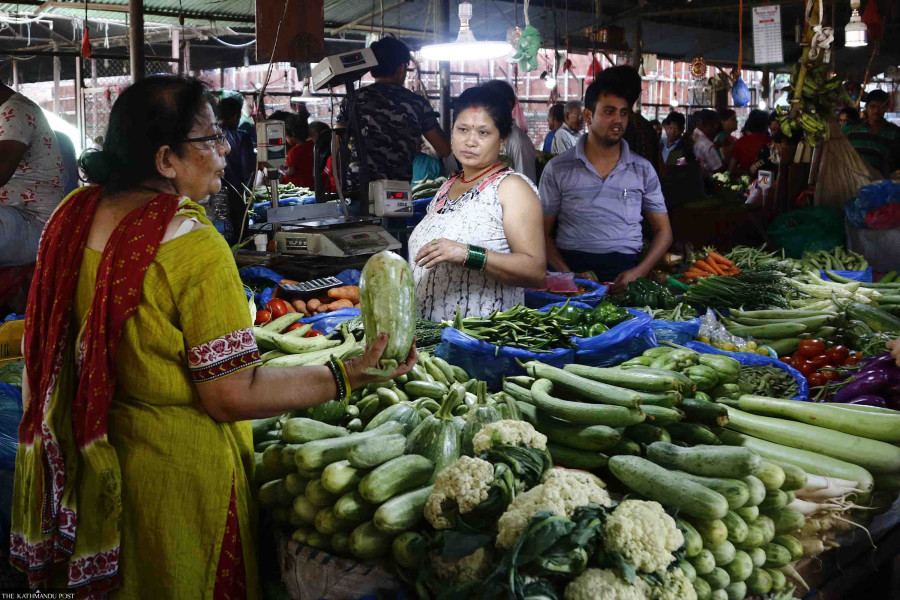Money
Valley's vegetable bazaar remains a seller's market
Consumers complain that they are forced to pay double the wholesale rate at retail stores due to lack of monitoring.
Subin Adhikari
Ankita Khatri had to pay Rs60 per kg of local tomato at a retail shop in Koteshwor even though they were selling it for Rs12 per kg at Kalimati, the country’s largest wholesale market.
Sanjog Pariyar paid Rs60 for a kilo of onion in Basantapur when it cost Rs40 per kilo at Kalimati, a distance of about 2 km.
Retail prices of vegetables have soared in Kathmandu Valley without any reason despite stable wholesale prices.
Vegetable traders say the winter—December-February—is the season for vegetable production. Despite abundant supply in the market, the prices, however, have not cooled down.
Consumers complain that they are forced to pay double the wholesale rate at retail stores due to lack of monitoring.
Wholesaler Minu Thapa Magar sells lemons. “The wholesale price of lemon has gone down this season to Rs100 per kilo, but the retail price is double that,” said Thapa Magar.
“I buy lemons imported from India through an agent. Then another agent buys them from me,” Thapa Magar said. “In the wholesale business, we don’t know the actual rate. There is no consistency in prices.”
Farmers are not getting fair prices for their products, but consumers are being forced to pay high prices.
The goods and services sold in Nepal normally pass through up to seven layers of middlemen, each adding a hefty mark-up, forcing consumers to pay unfairly high prices, according to a report of the Department of Commerce, Supply and Consumer Protection.
Multi-layered supply chains are mostly seen in the agricultural goods trade.
A product with a farm gate price of Rs10 ends up with a price tag of Rs70 by the time it reaches the customer, the report said.
In most businesses, a product passes from the manufacturer to the dealer, main distributor, national distributor, local distributor, wholesaler and retailer before reaching the final user.
According to Binaya Shrestha, spokesperson for the Kalimati Fruits and Vegetable Market Development Board, transporting vegetables to Kathmandu is so expensive that growers rely on middlemen or local collectors.
“Nepali farmers are usually small-scale producers. The vegetables they grow have to be collected and transported to market by agents which greatly increases their price when they reach Kathmandu.”
He said that vegetables perish en route most of the time, and middlemen have to recover their losses by jacking up prices of what has not spoiled.
“Then retailers and distributors take over and that increases the price further,” said Shrestha.
"Prices and quality are monitored at the Kalimati market, but after the vegetables leave the gate, retail prices go haywire.”
The profit margin, risk factor and transportation costs for each layer of middlemen ultimately make the price high for the final consumer, he said.
Muhammad Sohail, a vegetable wholesaler at Kalimati, says they adjust prices daily depending on how much inventory has perished. “Even then the average price of vegetables is lower this year compared to last year.”
Sohail supplies sword beans or simi, tomato, coriander and cauliflower grow in the Tarai.
As farmers in Kathmandu, Bhaktapur and Lalitpur have abandoned farming, vegetables are sourced from neighbouring districts like Makwanpur, Dhading, Kabhre and Chitwan.
Nowadays, a majority of the products come from India.
Pushpa Maharjan used to be a vegetable farmer, but nowadays he buys them at the local market.
“Output has decreased as tall buildings started to grow where they used to grow vegetables. The tall buildings block the sunlight, there is no irrigation, and chemical fertiliser is always short,” said Maharjan. “So it’s easier to buy vegetables than grow them.”
Gita Katwal, a retailer who sources green vegetables and carrots from Thimi in Bhaktapur, said farmers don’t have the resources and time to bring their goods to market.
“Therefore, we need to rely on several layers of middlemen. When these vegetables pass from one hand to another, even an addition of Rs10-15 at each stage results in the price increasing twofold for the end consumer,” said Katwal. “This is unfair for both farmers and consumers, but we have no option.”
Two vegetable traders with whom the Post talked said middlemen normally leased stalls at the Kalimati market for Rs10,000 per month to store green vegetables. They subrent it to other traders for Rs200,000 to Rs300,000 per month.”
The middlemen even rent out the same stall to multiple vendors on a shift basis. “These syndicates also contribute to keeping prices high as the steep rentals are added to the price of vegetables.”
The year-on-year consumer price inflation was 7.38 percent in mid-December 2022 compared to 7.11 percent a year ago, according to Nepal Rastra Bank. Food and beverage inflation stood at 5.85 percent whereas non-food and service inflation rose to 8.59 percent in the review month.
The year-on-year wholesale price index increased by 9.15 percent in the review month compared to 7.22 percent a year ago.




 7.12°C Kathmandu
7.12°C Kathmandu














